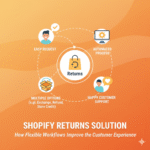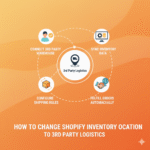Running a Shopify store is exciting until the returns start piling up. Every eCommerce brand faces it customers sending products back because they changed their mind, received the wrong size, or didn’t get what they expected.
Returns not only affect profits but also eat into logistics and customer support time. The real challenge is not eliminating returns completely (that’s impossible) but reducing them smartly using the right tools.
In this article, let’s talk about which platforms actually help Shopify brands lower their return rates and how you can use them to improve customer satisfaction and operational efficiency.
Why Returns Happen in Shopify Stores
Before we explore solutions, it’s important to understand why returns happen in the first place. From what I’ve seen with multiple Shopify brands, most returns come from:
- Product mismatch: The item doesn’t look or fit as expected.
- Confusing product descriptions: Missing size charts, unclear photos, or incomplete details.
- Shipping damage: Poor packaging or long delivery times.
- Impulse buys: Customers regret after receiving the product.
- Complicated exchange process: When it’s easier to return than to exchange.
Knowing why returns happen helps you decide where to focus your efforts — and that’s where the following platforms come in.
1. Loop Returns – Automated Returns and Exchanges
Best for: Streamlining the post-purchase experience.
Why it helps:
Loop Returns helps Shopify stores reduce return rates by promoting exchanges instead of refunds. Instead of customers sending products back, the tool encourages them to swap for a new size, color, or product.
Key features:
- Automated return and exchange flows.
- “Shop Now” credit for keeping customers engaged.
- In-depth analytics to understand why returns happen.
- Customizable return portal with your branding.
Impact:
Brands using Loop often report 10–15% fewer refunds and higher customer retention.
2. Returnly (by Affirm) – Simplify Returns with Store Credit
Best for: Fast refunds and loyal customer retention.
Why it helps:
Returnly gives instant store credit to customers even before their return is processed. This not only improves trust but also keeps customers shopping within your store instead of losing them to competitors.
Key features:
- Instant store credit and exchange options.
- Fraud detection to avoid misuse.
- Easy Shopify integration.
- Supports branded return centers.
Impact:
By keeping customers engaged with credit, Returnly can help reduce refunds by up to 20%.
3. Narvar – Improve Post-Purchase Experience
Best for: Mid-to-large Shopify brands with high order volumes.
Why it helps:
Narvar focuses on the customer journey after purchase. It ensures transparency with tracking, communication, and personalized messaging — which directly reduces returns caused by confusion or delivery delays.
Key features:
- Branded tracking pages with proactive updates.
- Smart return rules (exchanges, store credits, etc.).
- Analytics on return reasons and patterns.
Impact:
Brands using Narvar often see better NPS (Net Promoter Score) and up to 25% drop in preventable returns.
4. Happy Returns (by PayPal) – In-Person Drop-Offs and Smart Exchanges
Best for: Businesses targeting convenience and eco-friendly logistics.
Why it helps:
Happy Returns lets customers drop off returns at local “Return Bars” — without boxes or labels. This simple experience builds brand trust and reduces friction in the process.
Key features:
- 5,000+ drop-off points in the US.
- No-box, no-label return experience.
- Consolidated shipments to reduce costs and carbon footprint.
- Shopify integration for seamless sync.
Impact:
By making returns effortless, Happy Returns improves brand reputation while lowering unnecessary returns.
5. AfterShip Returns Center – Data-Driven Return Management
Best for: Shopify stores wanting analytics-focused returns control.
Why it helps:
AfterShip helps you understand why returns are happening using data. It offers automation, customizable workflows, and easy-to-use dashboards.
Key features:
- Multi-language return portals.
- Automated status notifications.
- Advanced reporting on return reasons.
- Integration with carriers and warehouses.
Impact:
With data insights, stores can fix recurring issues like inaccurate descriptions or packaging problems — cutting return rates significantly.
6. ReConvert – Post-Purchase Upselling and Feedback
Best for: Preventing returns before they happen.
Why it helps:
ReConvert helps stores collect post-purchase feedback and upsell recommendations. By understanding what went wrong with previous orders, you can fix issues that cause returns.
Key features:
- Custom thank-you pages with survey options.
- AI-powered upsell and cross-sell widgets.
- Integration with Klaviyo, Mailchimp, and more.
Impact:
Brands using ReConvert see better customer communication and fewer post-delivery complaints.
7. Gorgias – Customer Support That Prevents Returns
Best for: Shopify stores that handle lots of queries.
Why it helps:
Most returns start with a question: “How can I return this?” or “The size doesn’t fit.” With Gorgias, your support team can respond instantly, offer size charts, or suggest exchanges before the return process even starts.
Key features:
- Centralized chat, email, and social inbox.
- Automated replies for FAQs.
- Deep Shopify integration for order data.
Impact:
By resolving issues faster, Gorgias helps brands reduce unnecessary returns and boost customer satisfaction.
How to Pick the Right Return Solution
If you’re just starting out, you don’t need a complicated tool. Here’s a quick guide:
| Business Size | Recommended Platform | Main Goal |
|---|---|---|
| Small store | AfterShip or ReConvert | Data + Feedback |
| Mid-level brand | Loop or Returnly | Exchanges + Store Credit |
| Large enterprise | Narvar or Happy Returns | Automation + Brand Experience |
The best platform depends on your scale, customer volume, and type of products.
Wrapping Up
Reducing returns isn’t just about policies it’s about experience.
When customers trust your process and feel supported, they’re more likely to exchange rather than return.
If you’re a Shopify brand owner, test one or two of these tools, track your return reasons, and slowly optimize based on data. Over time, you’ll see your return rate drop while customer satisfaction and repeat sales rise.



Pingback: How to Change Shopify Inventory Location to a 3rd Party? - PratsDigital
Pingback: Why Is Business to Consumer (B2C) E-commerce So Convenient? - PratsDigital